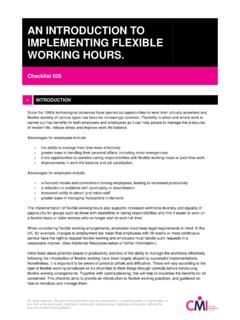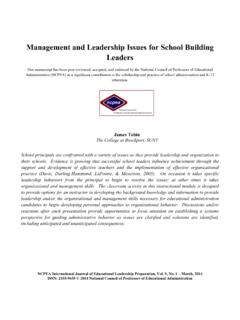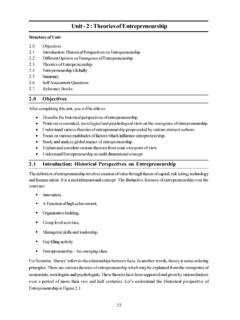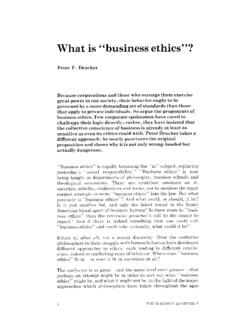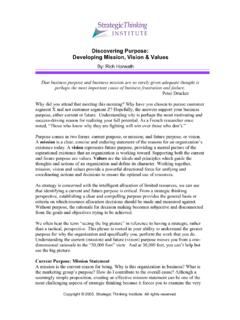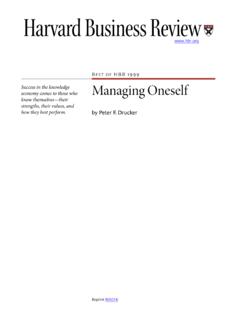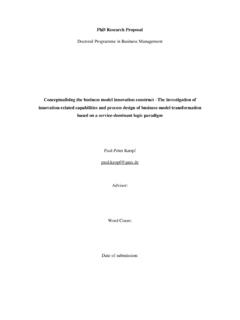Transcription of Setting SMART Objectives
1 Setting SMART . Objectives Checklist 231. Introduction Objectives set out what a business is trying to achieve. They should be based on organisational strategy and be aligned with corporate vision, mission and values. Objectives may be set at the level of the whole organisation or at divisional, department, team or individual levels. Lower level Objectives and project Objectives should ideally relate to one of more of the corporate level Objectives . Leaders and managers need to get the process of Setting Objectives right, as inadequately formulated Objectives can cause confusion or lead individuals, teams or the whole organisation in the wrong direction.
2 The process of objective Setting can seem intimidating but this is not necessarily the case. It can be as simple as sitting down with the departmental Objectives and considering how these Objectives can be met. The answer to this question will lay the the foundation for Setting specific Objectives for individuals. The SMART acronym is a tool designed to help organisations and individuals set Objectives in an effective and productive manner. Specific and measurable Objectives define the success of a project or initiative. Achievable and realistic Objectives engage and motivate individuals.
3 Time-bound Objectives ensure that all stakeholders agree time scales for the achievement of Objectives . Both peter drucker (1955) and (1991) have been credited with developing the model, although it is difficult to be certain whether either of these two were really the first people to use the term SMART ' with reference to Objectives . The concept of SMART Objectives is commonly used by managers to set individual Objectives within appraisal and performance management systems. Like many models, SMART has been criticised and a number of variations have been proposed.
4 These include SMARTER which adds Evaluated and Reviewed (or Rewarded) to the traditional framework. Definition An objective is a statement which describes what an individual, team or organisation is hoping to achieve. There are a number of different versions of the acronym with different terms associated with some of the letters as indicated below. Objectives are ' SMART ' if they are specific, measurable, achievable, (sometimes agreed), realistic (or relevant) and time-bound, (or timely). SMART specific, measurable, achievable, realistic and time-bound Specific outline in a clear statement precisely what is required.
5 Measurable include a measure to enable organisations to monitor progress and to know when the objective has been achieved. Achievable (or agreed) - design Objectives to be challenging, but ensure that failure is not built into Objectives . Objectives should be agreed by managers and employees to ensure commitment to them. Realistic (or relevant)- focus on outcomes rather than the means of achieving them All rights reserved. No part of this publication may be reproduced in a retrieval system, or transmitted, in any form or by any means, electronic, mechanical, photocopying, recording or otherwise, without the prior permission of the publisher.
6 Time-bound (or time-bound) agree the date by which the outcome must be achieved. Action checklist 1. Specific Objectives should be specific. They should describe the result that is desired in a way that is, detailed, focused and well defined. The following questions may be helpful in formulating specific Objectives : What outcomes are we looking for? Is it clear what the objective means? How will this be achieved and what strategies will be followed? What needs to happen? What are we going to do, with or for whom? Who will be responsible for what and do we need anyone else to be involved?
7 When do we want this to be completed? When writing Objectives , especially for individuals, use action-orientated verbs which describe what needs to be done to achieve the Objectives . For examples: analyse apply change create determine differentiate identify instigate perform. Avoid jargon, words and phrases which are (or can be construed as) misleading or ambiguous such as: be aware of have an awareness of be prepared for a variety of. 2. Measurable Measurement is hugely important because it will enable you to know whether an objective has been achieved.
8 To be measurable an objective should describe an achievement or outcome which is or can be related to a percentage, a frequency, rate or number. Evidence will need to be derived from a system, method or procedure which has tracked and recorded the outcomes related to the objective. To help in Setting measurable outcomes, think about the desired outcome and which elements can be measured. Consider whether there is any scope for cross-comparison. For example: if the objective is to increase sales in a certain area, it is a simple matter to check whether sales have changed in that area.
9 However, if sales are changing in all areas, you will need to show that the increase is related to actions related to the objective, rather than as part of a general trend. Consider these questions: How will I know that the change has occurred? Can these measurements be obtained? All rights reserved. No part of this publication may be reproduced in a retrieval system, or transmitted, in any form or by any means, electronic, mechanical, photocopying, recording or otherwise, without the prior permission of the publisher. 3. Achievable (or agreed).
10 An objective can be said to be achievable if the necessary resources are available or similar results have been achieved by others in similar circumstances. Questions to consider include: Who will carry out the actions required? Do they have the necessary skills to do the task well? Are the resources (personnel, funding, time, equipment etc.) to achieve this objective available or can they be obtained? Who will bear responsibility for what? Achievable' implies that those to whom it is assigned are willing and able to achieve it. If Objectives are seen to be unachievable those responsible for them are likely to lose motivation and become demoralised.

